Current Development in Accounting Thought: Analysis and Review
VerifiedAdded on 2020/02/24
|8
|2482
|138
Report
AI Summary
This report analyzes the current developments in accounting thought, focusing on the conceptual framework as defined by FASB and IFRS, highlighting its objectives and qualitative characteristics like relevance and faithful representation. It explores the trade-offs between these characteristics and discusses the evolution of accounting theory, contrasting normative and positive approaches. The report delves into various measurement methods, including Historical Cost Accounting (HCA), its limitations, and alternative methods like CPPA, CCA, CoCoA, and Fair Value Accounting (FVA). It further examines the building blocks of a conceptual framework, its advantages, and criticisms. The report emphasizes the importance of harmonizing accounting standards and provides a comprehensive overview of the evolution and current state of accounting practices.
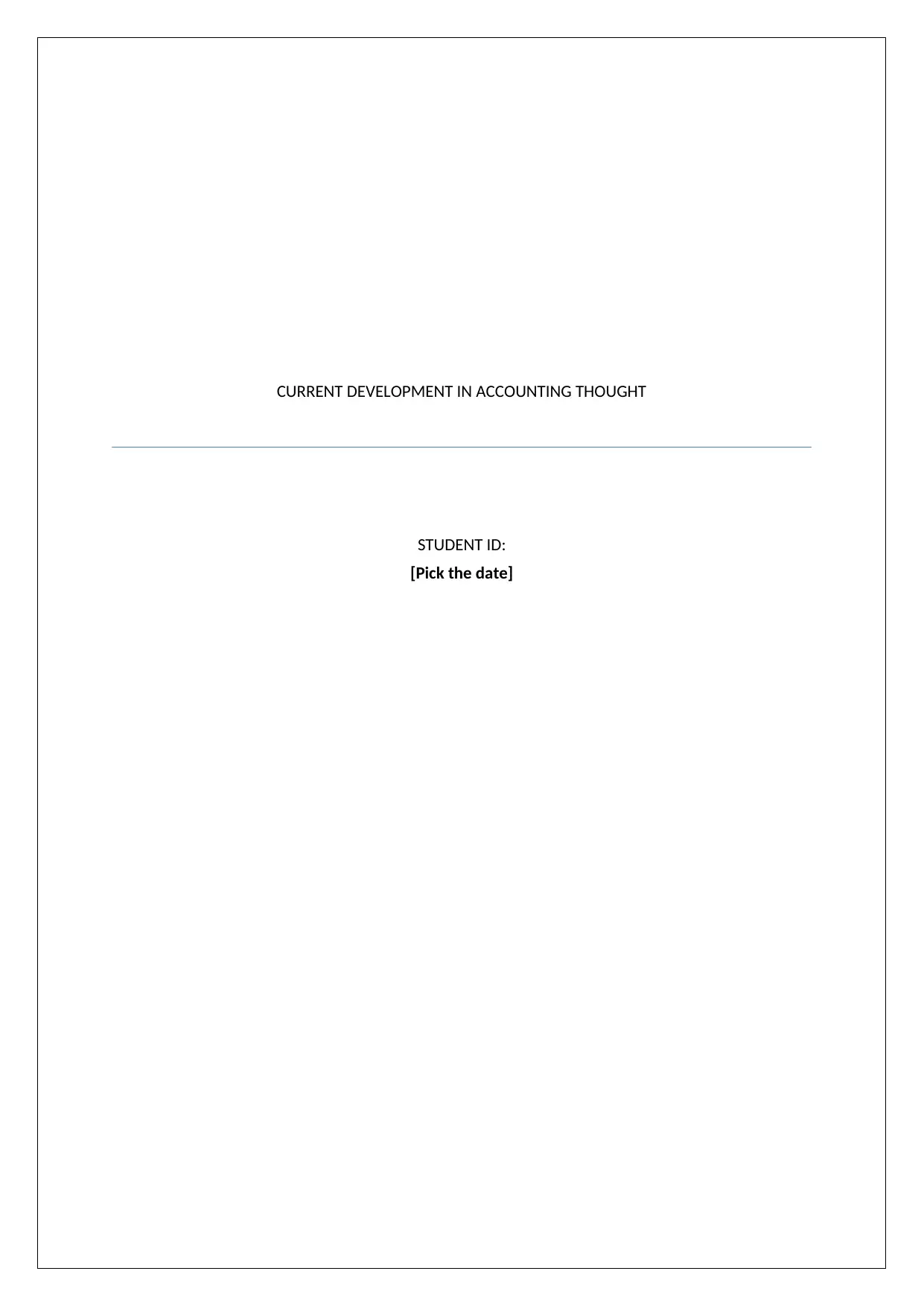
CURRENT DEVELOPMENT IN ACCOUNTING THOUGHT
STUDENT ID:
[Pick the date]
STUDENT ID:
[Pick the date]
Paraphrase This Document
Need a fresh take? Get an instant paraphrase of this document with our AI Paraphraser
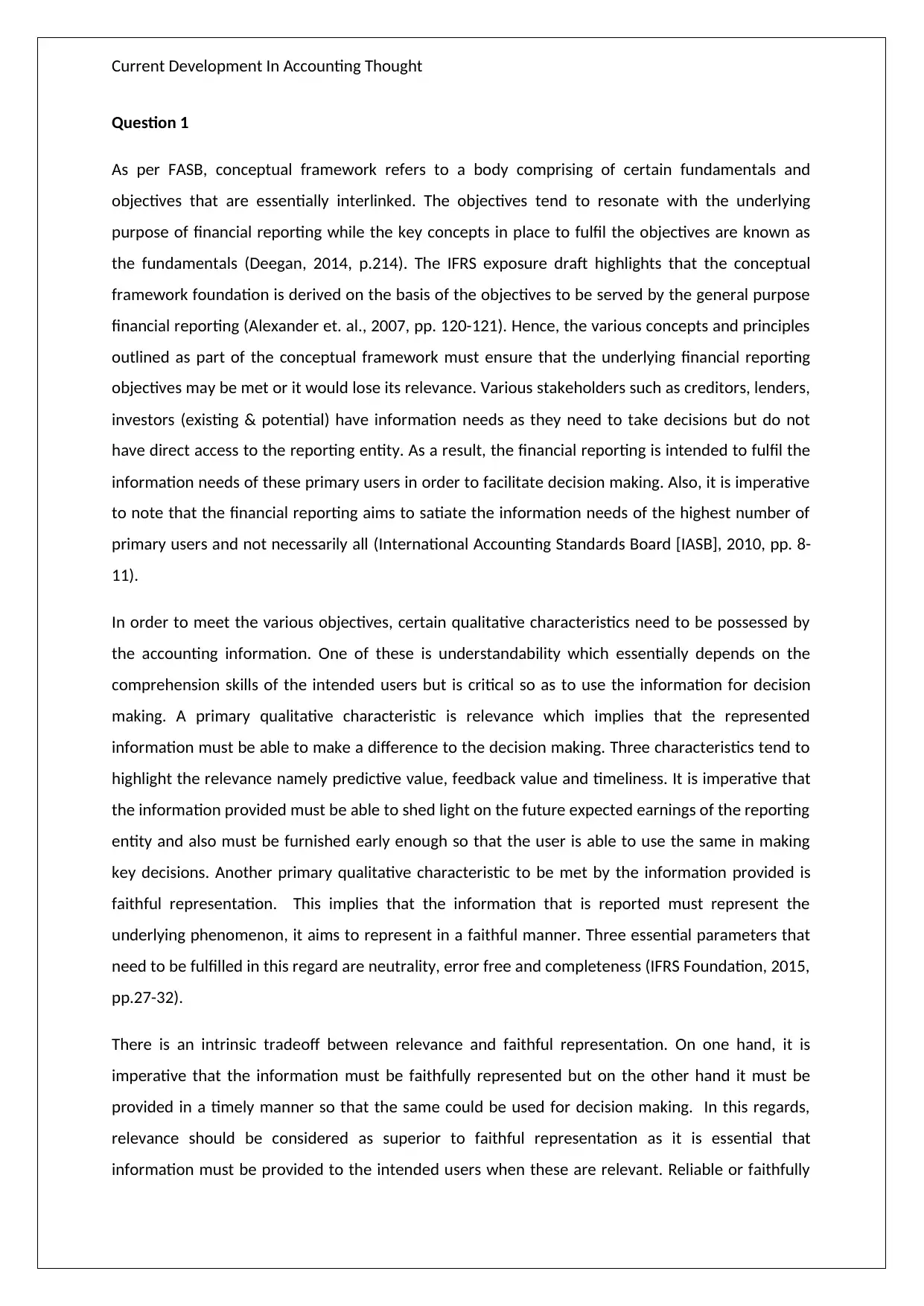
Current Development In Accounting Thought
Question 1
As per FASB, conceptual framework refers to a body comprising of certain fundamentals and
objectives that are essentially interlinked. The objectives tend to resonate with the underlying
purpose of financial reporting while the key concepts in place to fulfil the objectives are known as
the fundamentals (Deegan, 2014, p.214). The IFRS exposure draft highlights that the conceptual
framework foundation is derived on the basis of the objectives to be served by the general purpose
financial reporting (Alexander et. al., 2007, pp. 120-121). Hence, the various concepts and principles
outlined as part of the conceptual framework must ensure that the underlying financial reporting
objectives may be met or it would lose its relevance. Various stakeholders such as creditors, lenders,
investors (existing & potential) have information needs as they need to take decisions but do not
have direct access to the reporting entity. As a result, the financial reporting is intended to fulfil the
information needs of these primary users in order to facilitate decision making. Also, it is imperative
to note that the financial reporting aims to satiate the information needs of the highest number of
primary users and not necessarily all (International Accounting Standards Board [IASB], 2010, pp. 8-
11).
In order to meet the various objectives, certain qualitative characteristics need to be possessed by
the accounting information. One of these is understandability which essentially depends on the
comprehension skills of the intended users but is critical so as to use the information for decision
making. A primary qualitative characteristic is relevance which implies that the represented
information must be able to make a difference to the decision making. Three characteristics tend to
highlight the relevance namely predictive value, feedback value and timeliness. It is imperative that
the information provided must be able to shed light on the future expected earnings of the reporting
entity and also must be furnished early enough so that the user is able to use the same in making
key decisions. Another primary qualitative characteristic to be met by the information provided is
faithful representation. This implies that the information that is reported must represent the
underlying phenomenon, it aims to represent in a faithful manner. Three essential parameters that
need to be fulfilled in this regard are neutrality, error free and completeness (IFRS Foundation, 2015,
pp.27-32).
There is an intrinsic tradeoff between relevance and faithful representation. On one hand, it is
imperative that the information must be faithfully represented but on the other hand it must be
provided in a timely manner so that the same could be used for decision making. In this regards,
relevance should be considered as superior to faithful representation as it is essential that
information must be provided to the intended users when these are relevant. Reliable or faithfully
Question 1
As per FASB, conceptual framework refers to a body comprising of certain fundamentals and
objectives that are essentially interlinked. The objectives tend to resonate with the underlying
purpose of financial reporting while the key concepts in place to fulfil the objectives are known as
the fundamentals (Deegan, 2014, p.214). The IFRS exposure draft highlights that the conceptual
framework foundation is derived on the basis of the objectives to be served by the general purpose
financial reporting (Alexander et. al., 2007, pp. 120-121). Hence, the various concepts and principles
outlined as part of the conceptual framework must ensure that the underlying financial reporting
objectives may be met or it would lose its relevance. Various stakeholders such as creditors, lenders,
investors (existing & potential) have information needs as they need to take decisions but do not
have direct access to the reporting entity. As a result, the financial reporting is intended to fulfil the
information needs of these primary users in order to facilitate decision making. Also, it is imperative
to note that the financial reporting aims to satiate the information needs of the highest number of
primary users and not necessarily all (International Accounting Standards Board [IASB], 2010, pp. 8-
11).
In order to meet the various objectives, certain qualitative characteristics need to be possessed by
the accounting information. One of these is understandability which essentially depends on the
comprehension skills of the intended users but is critical so as to use the information for decision
making. A primary qualitative characteristic is relevance which implies that the represented
information must be able to make a difference to the decision making. Three characteristics tend to
highlight the relevance namely predictive value, feedback value and timeliness. It is imperative that
the information provided must be able to shed light on the future expected earnings of the reporting
entity and also must be furnished early enough so that the user is able to use the same in making
key decisions. Another primary qualitative characteristic to be met by the information provided is
faithful representation. This implies that the information that is reported must represent the
underlying phenomenon, it aims to represent in a faithful manner. Three essential parameters that
need to be fulfilled in this regard are neutrality, error free and completeness (IFRS Foundation, 2015,
pp.27-32).
There is an intrinsic tradeoff between relevance and faithful representation. On one hand, it is
imperative that the information must be faithfully represented but on the other hand it must be
provided in a timely manner so that the same could be used for decision making. In this regards,
relevance should be considered as superior to faithful representation as it is essential that
information must be provided to the intended users when these are relevant. Reliable or faithfully
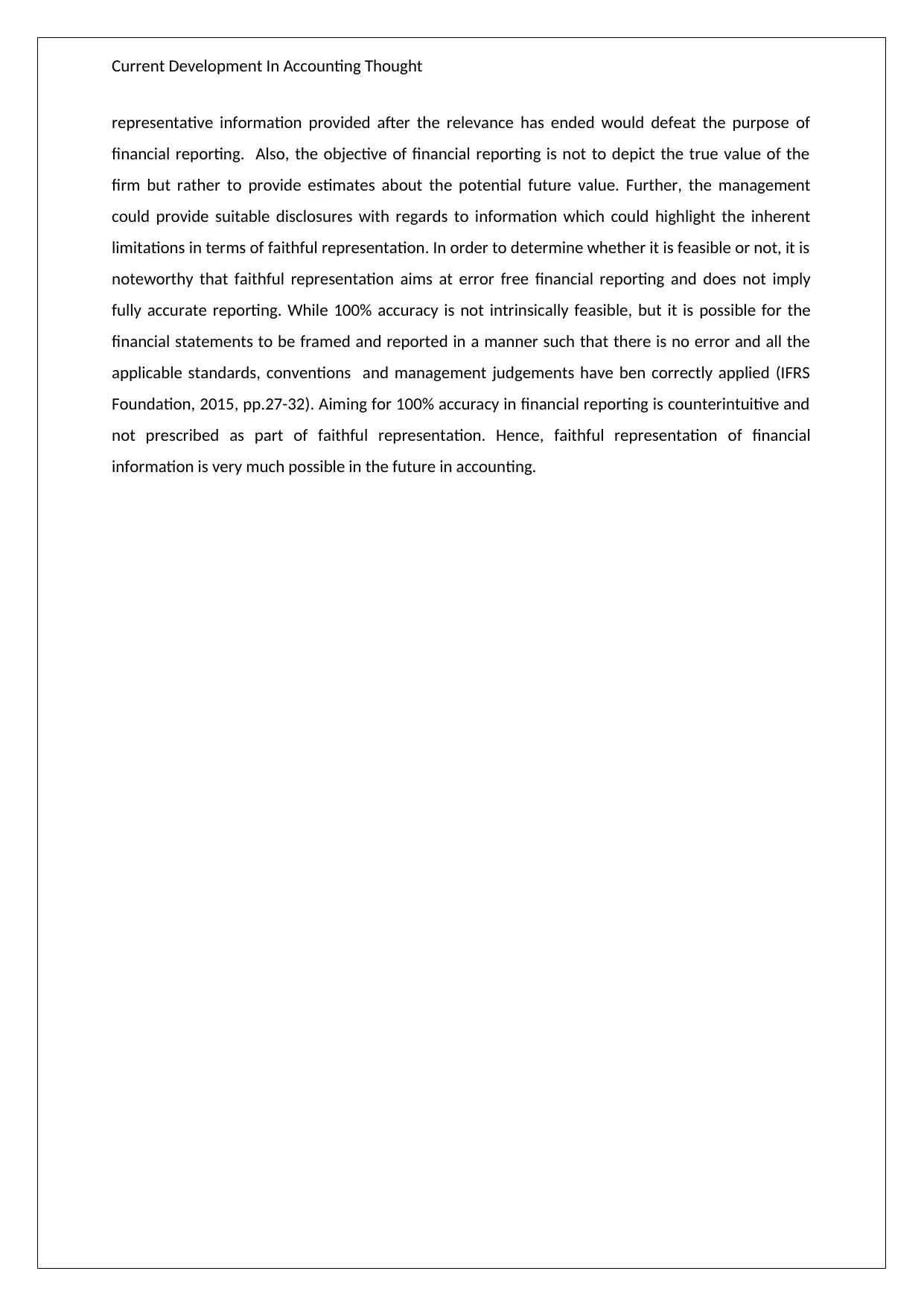
Current Development In Accounting Thought
representative information provided after the relevance has ended would defeat the purpose of
financial reporting. Also, the objective of financial reporting is not to depict the true value of the
firm but rather to provide estimates about the potential future value. Further, the management
could provide suitable disclosures with regards to information which could highlight the inherent
limitations in terms of faithful representation. In order to determine whether it is feasible or not, it is
noteworthy that faithful representation aims at error free financial reporting and does not imply
fully accurate reporting. While 100% accuracy is not intrinsically feasible, but it is possible for the
financial statements to be framed and reported in a manner such that there is no error and all the
applicable standards, conventions and management judgements have ben correctly applied (IFRS
Foundation, 2015, pp.27-32). Aiming for 100% accuracy in financial reporting is counterintuitive and
not prescribed as part of faithful representation. Hence, faithful representation of financial
information is very much possible in the future in accounting.
representative information provided after the relevance has ended would defeat the purpose of
financial reporting. Also, the objective of financial reporting is not to depict the true value of the
firm but rather to provide estimates about the potential future value. Further, the management
could provide suitable disclosures with regards to information which could highlight the inherent
limitations in terms of faithful representation. In order to determine whether it is feasible or not, it is
noteworthy that faithful representation aims at error free financial reporting and does not imply
fully accurate reporting. While 100% accuracy is not intrinsically feasible, but it is possible for the
financial statements to be framed and reported in a manner such that there is no error and all the
applicable standards, conventions and management judgements have ben correctly applied (IFRS
Foundation, 2015, pp.27-32). Aiming for 100% accuracy in financial reporting is counterintuitive and
not prescribed as part of faithful representation. Hence, faithful representation of financial
information is very much possible in the future in accounting.
⊘ This is a preview!⊘
Do you want full access?
Subscribe today to unlock all pages.

Trusted by 1+ million students worldwide
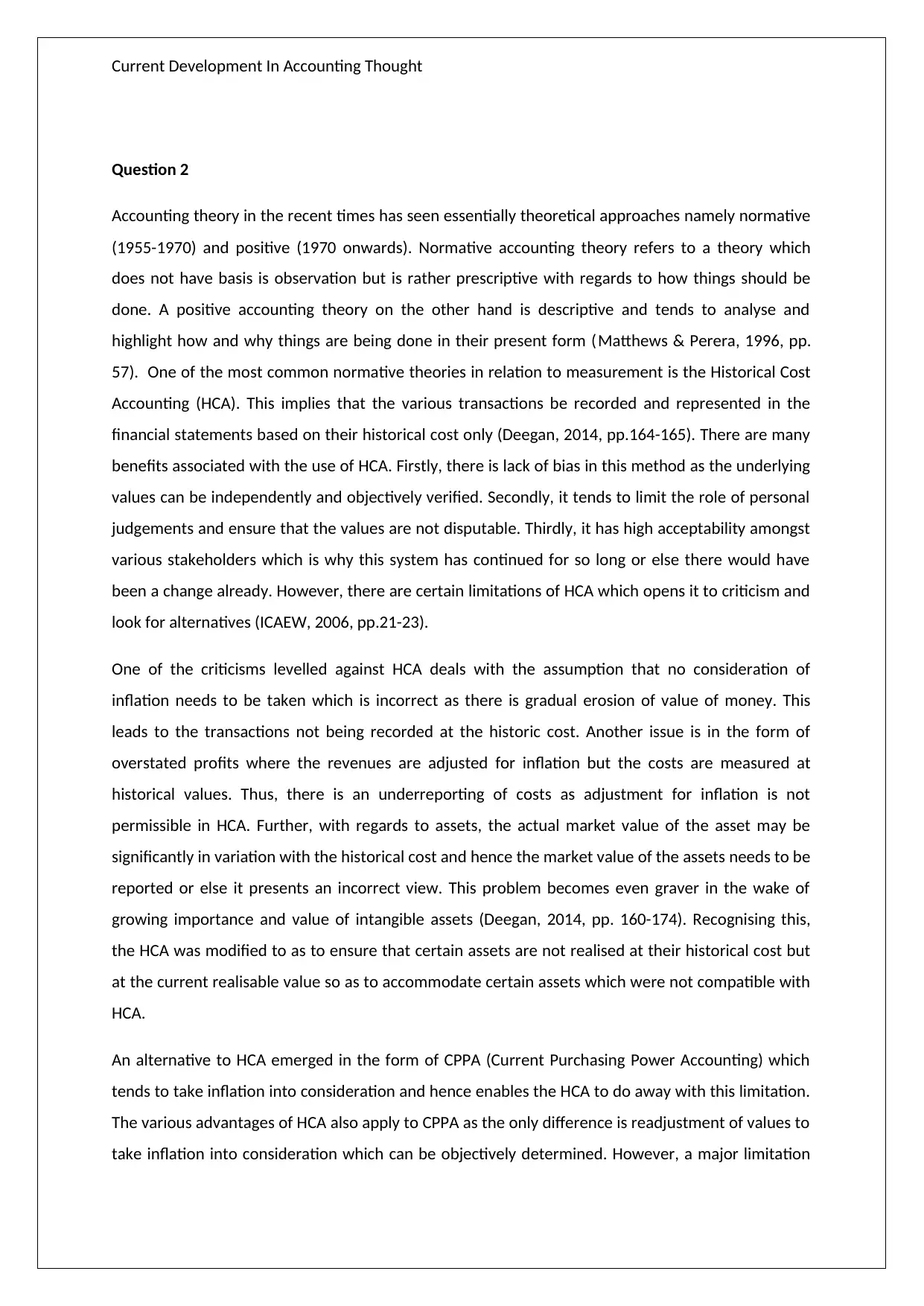
Current Development In Accounting Thought
Question 2
Accounting theory in the recent times has seen essentially theoretical approaches namely normative
(1955-1970) and positive (1970 onwards). Normative accounting theory refers to a theory which
does not have basis is observation but is rather prescriptive with regards to how things should be
done. A positive accounting theory on the other hand is descriptive and tends to analyse and
highlight how and why things are being done in their present form (Matthews & Perera, 1996, pp.
57). One of the most common normative theories in relation to measurement is the Historical Cost
Accounting (HCA). This implies that the various transactions be recorded and represented in the
financial statements based on their historical cost only (Deegan, 2014, pp.164-165). There are many
benefits associated with the use of HCA. Firstly, there is lack of bias in this method as the underlying
values can be independently and objectively verified. Secondly, it tends to limit the role of personal
judgements and ensure that the values are not disputable. Thirdly, it has high acceptability amongst
various stakeholders which is why this system has continued for so long or else there would have
been a change already. However, there are certain limitations of HCA which opens it to criticism and
look for alternatives (ICAEW, 2006, pp.21-23).
One of the criticisms levelled against HCA deals with the assumption that no consideration of
inflation needs to be taken which is incorrect as there is gradual erosion of value of money. This
leads to the transactions not being recorded at the historic cost. Another issue is in the form of
overstated profits where the revenues are adjusted for inflation but the costs are measured at
historical values. Thus, there is an underreporting of costs as adjustment for inflation is not
permissible in HCA. Further, with regards to assets, the actual market value of the asset may be
significantly in variation with the historical cost and hence the market value of the assets needs to be
reported or else it presents an incorrect view. This problem becomes even graver in the wake of
growing importance and value of intangible assets (Deegan, 2014, pp. 160-174). Recognising this,
the HCA was modified to as to ensure that certain assets are not realised at their historical cost but
at the current realisable value so as to accommodate certain assets which were not compatible with
HCA.
An alternative to HCA emerged in the form of CPPA (Current Purchasing Power Accounting) which
tends to take inflation into consideration and hence enables the HCA to do away with this limitation.
The various advantages of HCA also apply to CPPA as the only difference is readjustment of values to
take inflation into consideration which can be objectively determined. However, a major limitation
Question 2
Accounting theory in the recent times has seen essentially theoretical approaches namely normative
(1955-1970) and positive (1970 onwards). Normative accounting theory refers to a theory which
does not have basis is observation but is rather prescriptive with regards to how things should be
done. A positive accounting theory on the other hand is descriptive and tends to analyse and
highlight how and why things are being done in their present form (Matthews & Perera, 1996, pp.
57). One of the most common normative theories in relation to measurement is the Historical Cost
Accounting (HCA). This implies that the various transactions be recorded and represented in the
financial statements based on their historical cost only (Deegan, 2014, pp.164-165). There are many
benefits associated with the use of HCA. Firstly, there is lack of bias in this method as the underlying
values can be independently and objectively verified. Secondly, it tends to limit the role of personal
judgements and ensure that the values are not disputable. Thirdly, it has high acceptability amongst
various stakeholders which is why this system has continued for so long or else there would have
been a change already. However, there are certain limitations of HCA which opens it to criticism and
look for alternatives (ICAEW, 2006, pp.21-23).
One of the criticisms levelled against HCA deals with the assumption that no consideration of
inflation needs to be taken which is incorrect as there is gradual erosion of value of money. This
leads to the transactions not being recorded at the historic cost. Another issue is in the form of
overstated profits where the revenues are adjusted for inflation but the costs are measured at
historical values. Thus, there is an underreporting of costs as adjustment for inflation is not
permissible in HCA. Further, with regards to assets, the actual market value of the asset may be
significantly in variation with the historical cost and hence the market value of the assets needs to be
reported or else it presents an incorrect view. This problem becomes even graver in the wake of
growing importance and value of intangible assets (Deegan, 2014, pp. 160-174). Recognising this,
the HCA was modified to as to ensure that certain assets are not realised at their historical cost but
at the current realisable value so as to accommodate certain assets which were not compatible with
HCA.
An alternative to HCA emerged in the form of CPPA (Current Purchasing Power Accounting) which
tends to take inflation into consideration and hence enables the HCA to do away with this limitation.
The various advantages of HCA also apply to CPPA as the only difference is readjustment of values to
take inflation into consideration which can be objectively determined. However, a major limitation
Paraphrase This Document
Need a fresh take? Get an instant paraphrase of this document with our AI Paraphraser
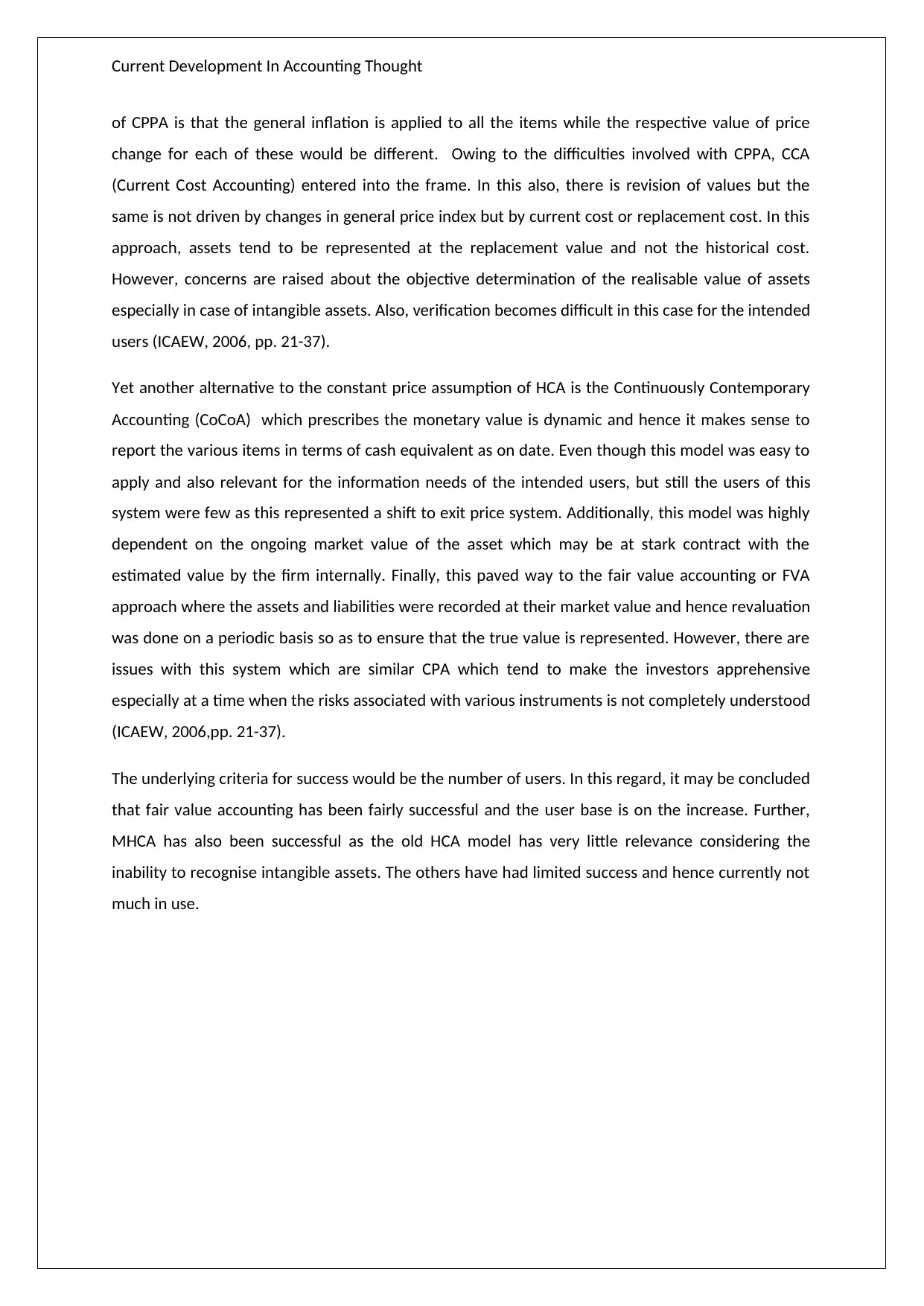
Current Development In Accounting Thought
of CPPA is that the general inflation is applied to all the items while the respective value of price
change for each of these would be different. Owing to the difficulties involved with CPPA, CCA
(Current Cost Accounting) entered into the frame. In this also, there is revision of values but the
same is not driven by changes in general price index but by current cost or replacement cost. In this
approach, assets tend to be represented at the replacement value and not the historical cost.
However, concerns are raised about the objective determination of the realisable value of assets
especially in case of intangible assets. Also, verification becomes difficult in this case for the intended
users (ICAEW, 2006, pp. 21-37).
Yet another alternative to the constant price assumption of HCA is the Continuously Contemporary
Accounting (CoCoA) which prescribes the monetary value is dynamic and hence it makes sense to
report the various items in terms of cash equivalent as on date. Even though this model was easy to
apply and also relevant for the information needs of the intended users, but still the users of this
system were few as this represented a shift to exit price system. Additionally, this model was highly
dependent on the ongoing market value of the asset which may be at stark contract with the
estimated value by the firm internally. Finally, this paved way to the fair value accounting or FVA
approach where the assets and liabilities were recorded at their market value and hence revaluation
was done on a periodic basis so as to ensure that the true value is represented. However, there are
issues with this system which are similar CPA which tend to make the investors apprehensive
especially at a time when the risks associated with various instruments is not completely understood
(ICAEW, 2006,pp. 21-37).
The underlying criteria for success would be the number of users. In this regard, it may be concluded
that fair value accounting has been fairly successful and the user base is on the increase. Further,
MHCA has also been successful as the old HCA model has very little relevance considering the
inability to recognise intangible assets. The others have had limited success and hence currently not
much in use.
of CPPA is that the general inflation is applied to all the items while the respective value of price
change for each of these would be different. Owing to the difficulties involved with CPPA, CCA
(Current Cost Accounting) entered into the frame. In this also, there is revision of values but the
same is not driven by changes in general price index but by current cost or replacement cost. In this
approach, assets tend to be represented at the replacement value and not the historical cost.
However, concerns are raised about the objective determination of the realisable value of assets
especially in case of intangible assets. Also, verification becomes difficult in this case for the intended
users (ICAEW, 2006, pp. 21-37).
Yet another alternative to the constant price assumption of HCA is the Continuously Contemporary
Accounting (CoCoA) which prescribes the monetary value is dynamic and hence it makes sense to
report the various items in terms of cash equivalent as on date. Even though this model was easy to
apply and also relevant for the information needs of the intended users, but still the users of this
system were few as this represented a shift to exit price system. Additionally, this model was highly
dependent on the ongoing market value of the asset which may be at stark contract with the
estimated value by the firm internally. Finally, this paved way to the fair value accounting or FVA
approach where the assets and liabilities were recorded at their market value and hence revaluation
was done on a periodic basis so as to ensure that the true value is represented. However, there are
issues with this system which are similar CPA which tend to make the investors apprehensive
especially at a time when the risks associated with various instruments is not completely understood
(ICAEW, 2006,pp. 21-37).
The underlying criteria for success would be the number of users. In this regard, it may be concluded
that fair value accounting has been fairly successful and the user base is on the increase. Further,
MHCA has also been successful as the old HCA model has very little relevance considering the
inability to recognise intangible assets. The others have had limited success and hence currently not
much in use.
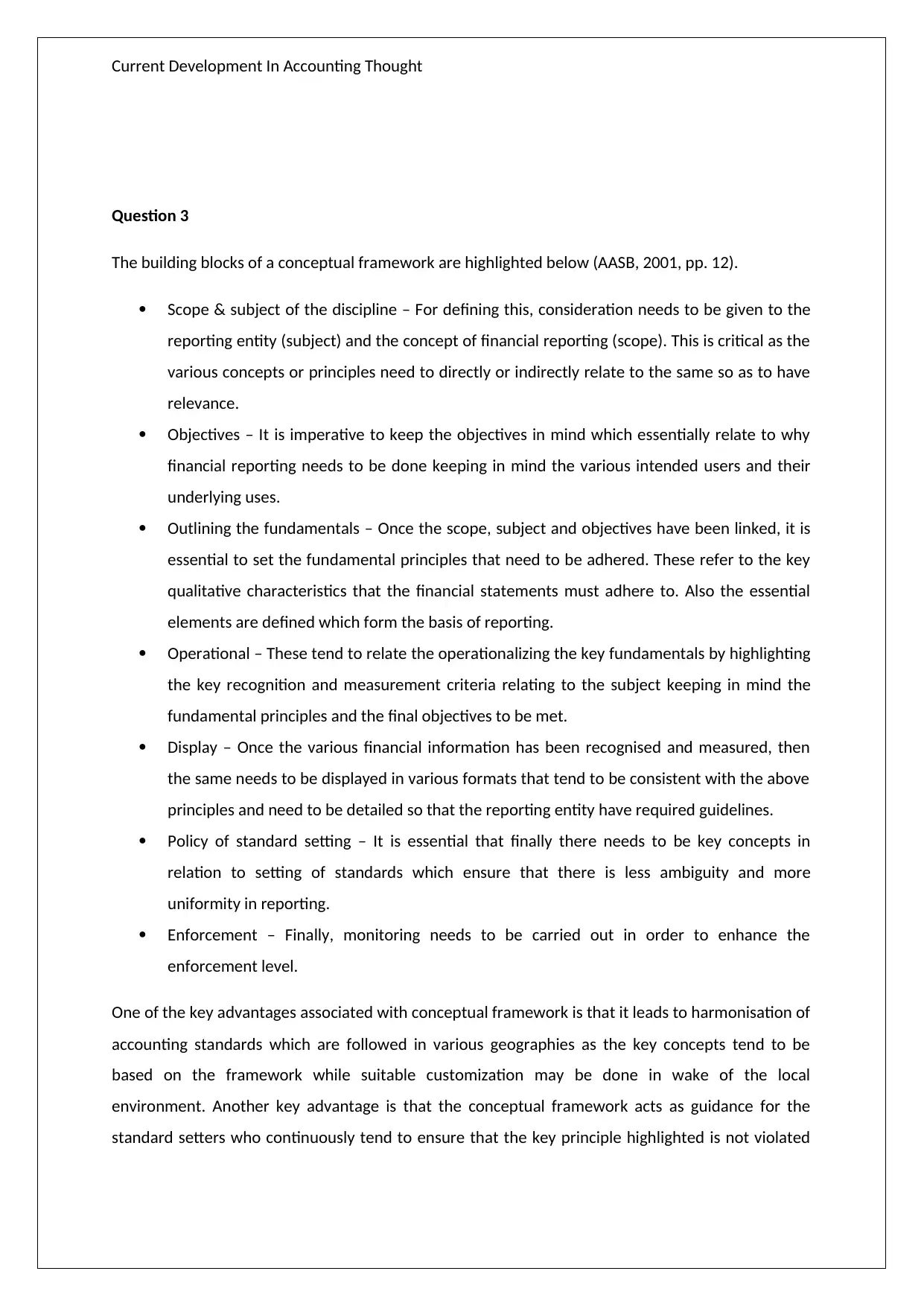
Current Development In Accounting Thought
Question 3
The building blocks of a conceptual framework are highlighted below (AASB, 2001, pp. 12).
Scope & subject of the discipline – For defining this, consideration needs to be given to the
reporting entity (subject) and the concept of financial reporting (scope). This is critical as the
various concepts or principles need to directly or indirectly relate to the same so as to have
relevance.
Objectives – It is imperative to keep the objectives in mind which essentially relate to why
financial reporting needs to be done keeping in mind the various intended users and their
underlying uses.
Outlining the fundamentals – Once the scope, subject and objectives have been linked, it is
essential to set the fundamental principles that need to be adhered. These refer to the key
qualitative characteristics that the financial statements must adhere to. Also the essential
elements are defined which form the basis of reporting.
Operational – These tend to relate the operationalizing the key fundamentals by highlighting
the key recognition and measurement criteria relating to the subject keeping in mind the
fundamental principles and the final objectives to be met.
Display – Once the various financial information has been recognised and measured, then
the same needs to be displayed in various formats that tend to be consistent with the above
principles and need to be detailed so that the reporting entity have required guidelines.
Policy of standard setting – It is essential that finally there needs to be key concepts in
relation to setting of standards which ensure that there is less ambiguity and more
uniformity in reporting.
Enforcement – Finally, monitoring needs to be carried out in order to enhance the
enforcement level.
One of the key advantages associated with conceptual framework is that it leads to harmonisation of
accounting standards which are followed in various geographies as the key concepts tend to be
based on the framework while suitable customization may be done in wake of the local
environment. Another key advantage is that the conceptual framework acts as guidance for the
standard setters who continuously tend to ensure that the key principle highlighted is not violated
Question 3
The building blocks of a conceptual framework are highlighted below (AASB, 2001, pp. 12).
Scope & subject of the discipline – For defining this, consideration needs to be given to the
reporting entity (subject) and the concept of financial reporting (scope). This is critical as the
various concepts or principles need to directly or indirectly relate to the same so as to have
relevance.
Objectives – It is imperative to keep the objectives in mind which essentially relate to why
financial reporting needs to be done keeping in mind the various intended users and their
underlying uses.
Outlining the fundamentals – Once the scope, subject and objectives have been linked, it is
essential to set the fundamental principles that need to be adhered. These refer to the key
qualitative characteristics that the financial statements must adhere to. Also the essential
elements are defined which form the basis of reporting.
Operational – These tend to relate the operationalizing the key fundamentals by highlighting
the key recognition and measurement criteria relating to the subject keeping in mind the
fundamental principles and the final objectives to be met.
Display – Once the various financial information has been recognised and measured, then
the same needs to be displayed in various formats that tend to be consistent with the above
principles and need to be detailed so that the reporting entity have required guidelines.
Policy of standard setting – It is essential that finally there needs to be key concepts in
relation to setting of standards which ensure that there is less ambiguity and more
uniformity in reporting.
Enforcement – Finally, monitoring needs to be carried out in order to enhance the
enforcement level.
One of the key advantages associated with conceptual framework is that it leads to harmonisation of
accounting standards which are followed in various geographies as the key concepts tend to be
based on the framework while suitable customization may be done in wake of the local
environment. Another key advantage is that the conceptual framework acts as guidance for the
standard setters who continuously tend to ensure that the key principle highlighted is not violated
⊘ This is a preview!⊘
Do you want full access?
Subscribe today to unlock all pages.

Trusted by 1+ million students worldwide
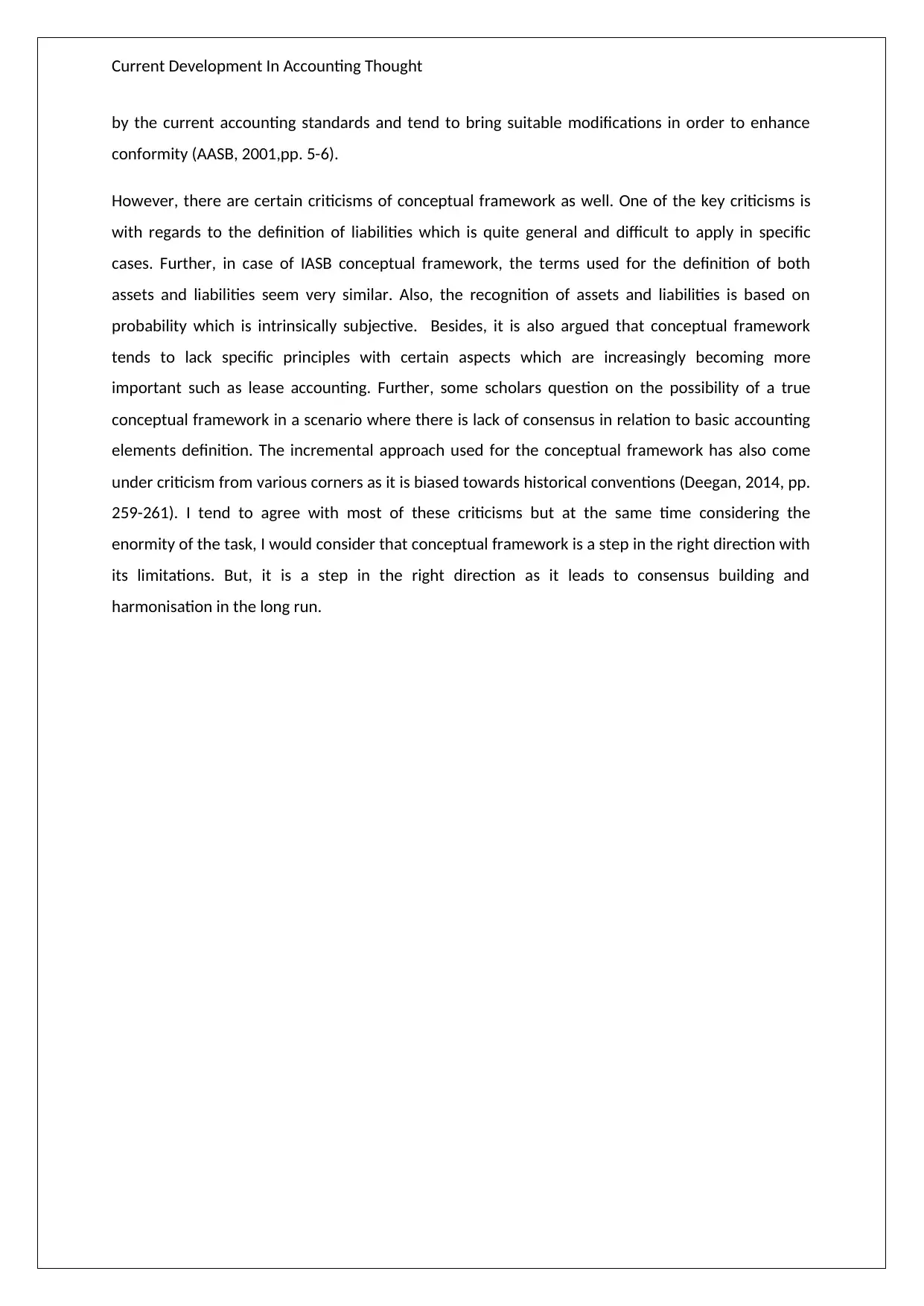
Current Development In Accounting Thought
by the current accounting standards and tend to bring suitable modifications in order to enhance
conformity (AASB, 2001,pp. 5-6).
However, there are certain criticisms of conceptual framework as well. One of the key criticisms is
with regards to the definition of liabilities which is quite general and difficult to apply in specific
cases. Further, in case of IASB conceptual framework, the terms used for the definition of both
assets and liabilities seem very similar. Also, the recognition of assets and liabilities is based on
probability which is intrinsically subjective. Besides, it is also argued that conceptual framework
tends to lack specific principles with certain aspects which are increasingly becoming more
important such as lease accounting. Further, some scholars question on the possibility of a true
conceptual framework in a scenario where there is lack of consensus in relation to basic accounting
elements definition. The incremental approach used for the conceptual framework has also come
under criticism from various corners as it is biased towards historical conventions (Deegan, 2014, pp.
259-261). I tend to agree with most of these criticisms but at the same time considering the
enormity of the task, I would consider that conceptual framework is a step in the right direction with
its limitations. But, it is a step in the right direction as it leads to consensus building and
harmonisation in the long run.
by the current accounting standards and tend to bring suitable modifications in order to enhance
conformity (AASB, 2001,pp. 5-6).
However, there are certain criticisms of conceptual framework as well. One of the key criticisms is
with regards to the definition of liabilities which is quite general and difficult to apply in specific
cases. Further, in case of IASB conceptual framework, the terms used for the definition of both
assets and liabilities seem very similar. Also, the recognition of assets and liabilities is based on
probability which is intrinsically subjective. Besides, it is also argued that conceptual framework
tends to lack specific principles with certain aspects which are increasingly becoming more
important such as lease accounting. Further, some scholars question on the possibility of a true
conceptual framework in a scenario where there is lack of consensus in relation to basic accounting
elements definition. The incremental approach used for the conceptual framework has also come
under criticism from various corners as it is biased towards historical conventions (Deegan, 2014, pp.
259-261). I tend to agree with most of these criticisms but at the same time considering the
enormity of the task, I would consider that conceptual framework is a step in the right direction with
its limitations. But, it is a step in the right direction as it leads to consensus building and
harmonisation in the long run.
Paraphrase This Document
Need a fresh take? Get an instant paraphrase of this document with our AI Paraphraser
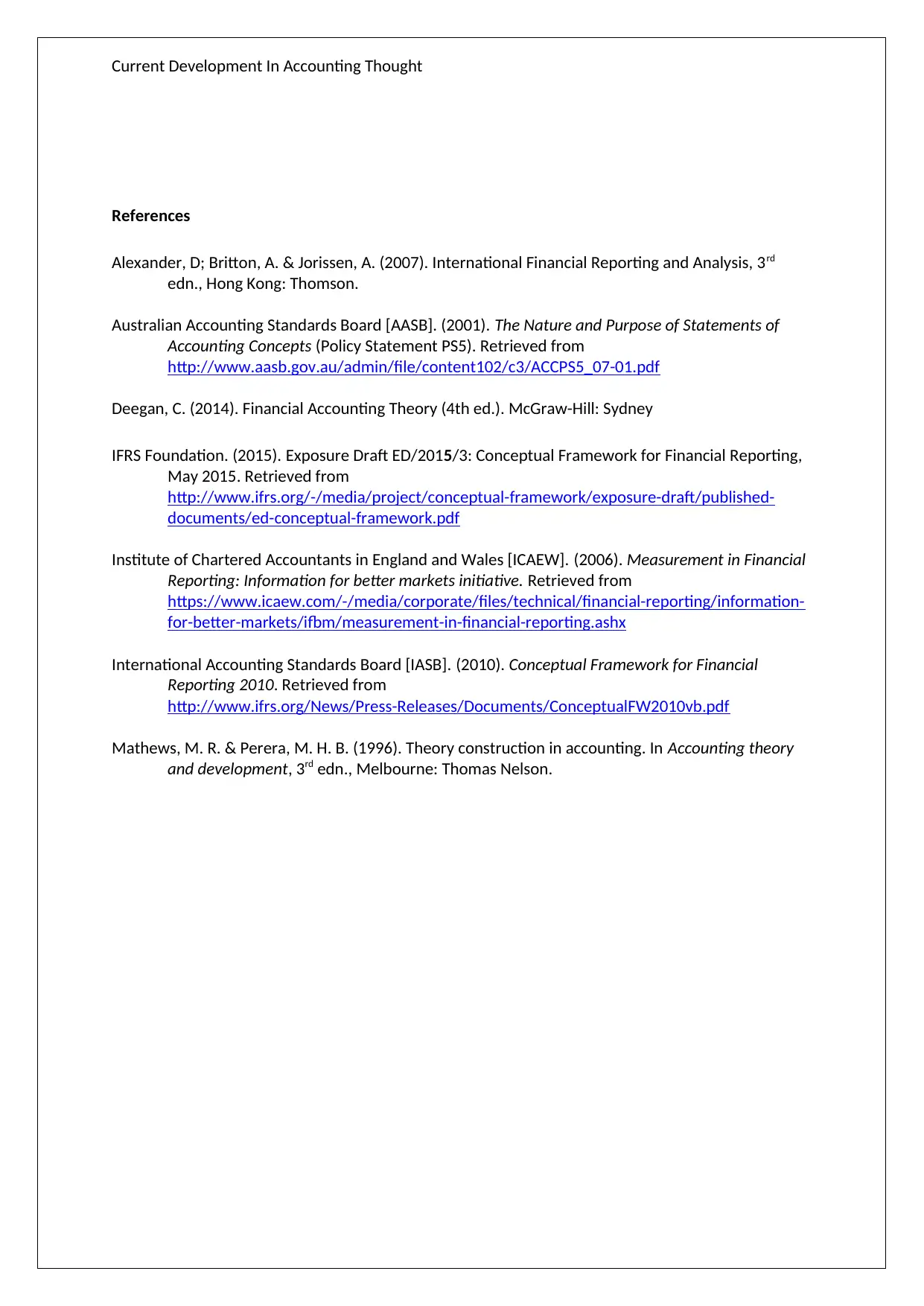
Current Development In Accounting Thought
References
Alexander, D; Britton, A. & Jorissen, A. (2007). International Financial Reporting and Analysis, 3rd
edn., Hong Kong: Thomson.
Australian Accounting Standards Board [AASB]. (2001). The Nature and Purpose of Statements of
Accounting Concepts (Policy Statement PS5). Retrieved from
http://www.aasb.gov.au/admin/file/content102/c3/ACCPS5_07-01.pdf
Deegan, C. (2014). Financial Accounting Theory (4th ed.). McGraw-Hill: Sydney
IFRS Foundation. (2015). Exposure Draft ED/2015/3: Conceptual Framework for Financial Reporting,
May 2015. Retrieved from
http://www.ifrs.org/-/media/project/conceptual-framework/exposure-draft/published-
documents/ed-conceptual-framework.pdf
Institute of Chartered Accountants in England and Wales [ICAEW]. (2006). Measurement in Financial
Reporting: Information for better markets initiative. Retrieved from
https://www.icaew.com/-/media/corporate/files/technical/financial-reporting/information-
for-better-markets/ifbm/measurement-in-financial-reporting.ashx
International Accounting Standards Board [IASB]. (2010). Conceptual Framework for Financial
Reporting 2010. Retrieved from
http://www.ifrs.org/News/Press-Releases/Documents/ConceptualFW2010vb.pdf
Mathews, M. R. & Perera, M. H. B. (1996). Theory construction in accounting. In Accounting theory
and development, 3rd edn., Melbourne: Thomas Nelson.
References
Alexander, D; Britton, A. & Jorissen, A. (2007). International Financial Reporting and Analysis, 3rd
edn., Hong Kong: Thomson.
Australian Accounting Standards Board [AASB]. (2001). The Nature and Purpose of Statements of
Accounting Concepts (Policy Statement PS5). Retrieved from
http://www.aasb.gov.au/admin/file/content102/c3/ACCPS5_07-01.pdf
Deegan, C. (2014). Financial Accounting Theory (4th ed.). McGraw-Hill: Sydney
IFRS Foundation. (2015). Exposure Draft ED/2015/3: Conceptual Framework for Financial Reporting,
May 2015. Retrieved from
http://www.ifrs.org/-/media/project/conceptual-framework/exposure-draft/published-
documents/ed-conceptual-framework.pdf
Institute of Chartered Accountants in England and Wales [ICAEW]. (2006). Measurement in Financial
Reporting: Information for better markets initiative. Retrieved from
https://www.icaew.com/-/media/corporate/files/technical/financial-reporting/information-
for-better-markets/ifbm/measurement-in-financial-reporting.ashx
International Accounting Standards Board [IASB]. (2010). Conceptual Framework for Financial
Reporting 2010. Retrieved from
http://www.ifrs.org/News/Press-Releases/Documents/ConceptualFW2010vb.pdf
Mathews, M. R. & Perera, M. H. B. (1996). Theory construction in accounting. In Accounting theory
and development, 3rd edn., Melbourne: Thomas Nelson.
1 out of 8
Related Documents
Your All-in-One AI-Powered Toolkit for Academic Success.
+13062052269
info@desklib.com
Available 24*7 on WhatsApp / Email
![[object Object]](/_next/static/media/star-bottom.7253800d.svg)
Unlock your academic potential
Copyright © 2020–2025 A2Z Services. All Rights Reserved. Developed and managed by ZUCOL.





